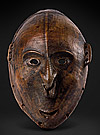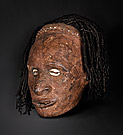Learn more
The Sepik River environment
The Sepik River flows over 1000 kilometres from its headwaters through a huge flat basin of lowland swamp and riverina forest out into the Bismarck Sea. The mouth of the river between the Murik and Watam lakes is approximately 1.5 kilometres wide and muddy fresh water can be seen up to 25 kilometres offshore.
The Sepik's course is broken only by a handful of hills as it twists and turns in snake-like patterns through the flat basin. As the river breaks its banks during the wet season (November to March), creating vast floodplains, houses are raised on posts and transport is by canoe. Continually shifting its course with each wet and dry season, large chunks of the riverbank dislodge to create floating islands of living vegetation knotted together by the roots of plants. These can be very large, giving the impression of being stable ground, and drift until becoming lodged, helping to form the hundreds of backwater oxbow lakes that team with fish and bird life.
Bordering the river are large sections of sago, a dietary staple, swathes of wild sugarcane, tall grasslands and bush where pigs, cassowaries, smaller mammals and numerous species of birds live. In the river itself are a variety of fish, eels, prawns and lobsters, and even sharks and sawfish in its shallower depths. The most revered and respected inhabitant is the saltwater crocodile, an animal perfectly adapted to the environment.




![| Paki [guardian figure] | Early 20th century prior to 1938](images/sml/243511.jpg)
![| Brag [mask] | Early 20th Century prior to 1922](images/sml/240765.jpg)

![| Atei [ancestor board] | 19th to early 20th Century prior to 1918](images/sml/240756.jpg)






![| Wusear [figure from a flute] |](images/sml/240777.jpg)